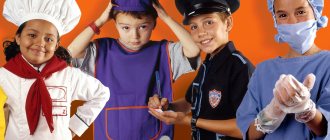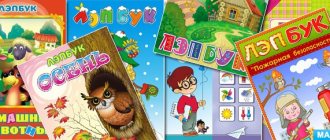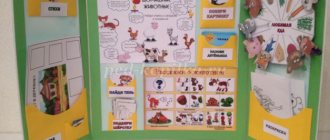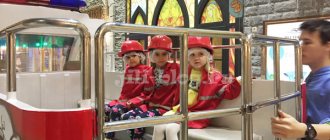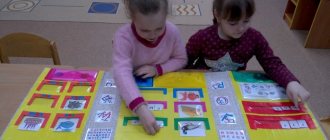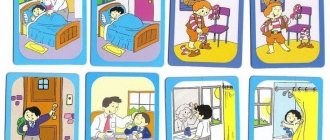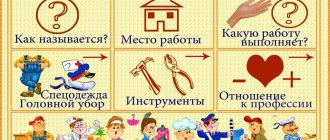Who develops the manual
The author of a lapbook is usually a teacher. But if for younger preschool age the teacher is involved in both the selection of material and its design, then in the middle group parents can get involved in the design and search for information.
For example, in my practice, as part of the discussion of the topic “Professions,” I give students and their parents a project task to write a story about the professions that we cannot do without. Or compile a manual with pictures, riddles, games dedicated to one profession.
In older preschool age, children take an active part in the selection of materials for designing a lapbook: they find illustrations, cut them out, and glue them. As in the middle group, mothers and fathers are actively involved in the search for materials, for example, they compose crosswords, puzzles on the topic, or collect a “data bank” about the professions of the future (city farmer engaged in landscaping megalopolises, developer of home robots, etc.).
Parents and children can offer materials for a group lapbook, and the teacher selects the most suitable and necessary information on the topic
What is a lapbook
This is a didactic aid used by teachers and parents to make it easier for the child to perceive the material, which is presented in an attractive playful way.
Its use is effective in developmental classes for children of senior preschool and sometimes primary school age. The subject of lapbooks can be different, but most often they are used to master knowledge that is not related to the main curriculum. The bright folder attracts the child’s attention, and the tasks and interactive component involve the child in the learning process through direct participation, rather than listening to boring stories from the teacher. The “Professions” laptop book can contain information about several popular types of activities, their features, equipment used in work, uniforms or tools. It is best to use the manual in a group as part of a separate project or thematic week. This, in addition to gaining knowledge, will give the child the ability to work in a team.
How the “Professions” lapbook is developed
There are no restrictions on the flight of creative thought when preparing a manual; there are only a number of subtleties identified experimentally:
- the manual must be strong, as it is intended for active use, which means it is better to choose plastic folders or hard cardboard (for example, from packaging household appliances) for the base;
- materials - cards, pictures - must be laminated or covered with tape;
- pockets for storing materials must be firmly attached to the base (with glue or double-sided tape);
- the contents of the lapbook can be organized with separate cards, folding books or a window with a retractable tape (for example, for the game “Tell me what you want to become” - the child moves the tape and an image of a particular profession appears in the window, which needs to be told about and commented on whether the child would like to become a specialist in this profile).
As for the content of the manual, it must comply with the program material on the topic “Professions”, as well as the requirements of the Federal State Educational Standard regarding the knowledge, skills and abilities that children of a particular age should possess.
Table: nuances of choosing the content of “Professions” lapbook blocks in different groups
| Material block | Why is it included in the manual? | Peculiarities of consideration in different groups |
| Informational | To familiarize yourself with the topic. The information block is the basis of the manual, on which the rest of the materials are focused (visualization, games, etc.) | In the first junior group, children get acquainted with professions, with the results of the work of specialists that they encounter in everyday life: a cook prepares food in kindergarten, a driver drives the bus on which mother goes to work, a doctor treats if they are sick. |
| In the second junior group, children expand their knowledge about a person’s occupation (teacher, hairdresser, accountant, etc.), and also consider the topic in the context of the professional occupations of their loved ones (“My mother is a teacher,” etc.). | ||
| In the middle group, children learn to correlate a profession with the tools and materials that are needed for specialists in this profile (a car for a driver, a pointer for a teacher, a white coat, medicines, a phonendoscope for a doctor, etc.). | ||
| In the senior group, children form a generalized concept of “profession”, expand their ideas about labor actions, about specialties that were, are and will be relevant in the world. | ||
| In the preparatory group, children generalize their existing knowledge, and also form primary ideas about the importance of choosing a profession in a person’s life, and get acquainted with the professions of the future. | ||
| Literary (stories, poems) | To form images of professions, instill respect for work. | Younger preschoolers can be introduced to the topic with the help of “Tales of Missing Professions,” which focuses on the importance of having specialists in each field, as well as by drawing on excerpts from K. Chukovsky’s work “Doctor Aibolit.” |
In the middle group, you can include the poem “What do you have” by S. Mikhalkov in a lapbook, building on its basis a conversation on the topic “Why the professions of our mothers and fathers are important”:
| ||
For older preschoolers, the selection can include:
| ||
| Puzzles | To consolidate and repeat material. | In early preschool age, it is better to select tasks with rhyming answers, since it is still difficult for children to work with the “classic” version of riddles. For middle and older students, this block includes riddles about things directly related to the profession. |
| Visual | To add aesthetics to the manual and better assimilation of the material. In addition, the manual includes cartoons on the topic. | In the younger group, the visual block includes pictures depicting representatives of different professions to illustrate the teacher’s stories; in the second youngest group, the kids themselves describe the pictures in 3-4 sentences. In the middle group, based on the pictures, children compose a generalized story about the profession in 4–5 sentences, and in the older groups they supplement the story with their opinion regarding a particular specialty, try to imagine how our life would change without this profession (in 6–8 sentences) . |
| Creative (coloring, sculpting) | To consolidate materials, develop creative abilities and expand cognitive interests. | In early preschool age, children work with pictures that do not have a lot of details. In the middle and senior groups, children paint specialists in the surroundings of their professional activities (a doctor examining a patient, a teacher in a lesson). Starting from the middle group, this block can include step-by-step instructions for modeling on topics related to professions. |
| Block with puzzles and crosswords | To work with this block, children need to have an understanding of letters and also be able to write, so it is used only in lapbooks for older preschoolers. For toddlers and middle preschool children, you can use “Find the Differences” pictures. |
Video: cartoon presentation of professions for younger preschoolers
Video: cartoon “In the world of professions” for preschoolers
Benefits of use
Unlike other common teaching materials (maps, illustrations, games, competitions), the Profession lapbook allows the child to feel independent choice. The kid is directly involved in everything that happens, he himself determines the profession he likes, finds cards with images of workers, correlates them with the necessary attributes, and describes the main functions of the employee. This approach helps in socializing children, developing their imaginative and logical thinking, and developing the ability to take responsibility for their decisions.
Lapbooks are usually developed by teachers, but the participation of parents in the process of selecting and registering professions will also be useful. This will allow us to include more interesting and relevant activities in the list today. Teachers often make the mistake of using the same material for years, not paying attention to changes in the labor market. Older preschoolers can also actively participate in creating an album about professions (look for suitable pictures in magazines, cut and paste them, sort them in different directions).
The main tasks performed by a laptop:
- educational: to show the importance of work and the need for different professions, to form a conscious attitude towards them;
- developmental: help improve attention, coherent speech, memory, thinking, imagination. In addition, the development of fine motor skills and the ability to communicate with peers and elders are of great importance;
- educational: increasing respect for work, including one’s parents, developing skills of independence and cooperation.
The baby learns to independently collect and classify the necessary information. Increasing the child’s knowledge about various types of useful work, their significance for society, features, disadvantages and advantages is a good basis for broadening their horizons and increasing interest in the world around them.
Now the “Profession” lapbook can be bought in a store or ordered online (several files in PDF format for 15–20 A4 sheets cost 200–300 rubles). However, in order to unite a team of adults and children with a common goal, it is better to create it yourself. Some make it from scrap materials, others find everything they need on the Internet, create a layout on the computer, and then print it out on a color printer and paste it onto cardboard blanks.
A selection of materials for the laptop “Professions”
When choosing materials, the teacher is guided by the program, the Federal State Educational Standard and the level of development of children in a particular group.
Information block
As text to illustrate thematic pictures, you can use descriptions of modern professions (Teacher, Manager, Hairdresser, etc. and Accountant, Cook, Seller, etc.). And for older preschoolers, it is worth including information about the professions of the future in the lapbook.
To summarize professions by area of application, you can make a “Profession Country Map”, distributing specialties in several areas: “City of Services” (hairdresser, salesman, etc.), “City of Knowledge” (scientist, teacher, etc.), etc. Based on the description of each city, children lay out pictures depicting the corresponding specialists.
The guys write a separate story-description about each “city”
To facilitate the task of telling about a profession using a picture, children in the middle and older groups can be offered a visual plan.
A plan with illustrations helps to create a story about the profession even for those who cannot yet read
Poems
In a block with rhyming for younger preschoolers you can include:
- Give the cook the food: Poultry, dried fruits, Rice, potatoes... And then delicious food awaits you.
- In the morning the sun shines brightly, the milkmaid carries the milk. Warm, cow, good for children's health.
- Give me scissors and a comb, He will do your hair. The hairdresser will certainly give you a modern haircut.
- A hammer is needed for work, and a carpenter is friendly with a saw. He sawed the planks and made a birdhouse.
For middle and senior preschool age, a selection can be compiled based on materials from the collection published here.
Puzzles
Rhymes with “agreements” about professions are usually included in the manual for the middle group, but in a lapbook for kids it can be used in fragments.
For middle and older groups, the selection can also include riddles about tools:
- He sews everything in the world. What he sews, he doesn’t put on (Needle);
- I run along my bald head - I cut the curls from my bald head (Plane);
- A lot of friendly guys are sitting on one pillar. As they begin to frolic - Only dust swirls around (Broom).
Riddles dedicated to specific professions can be found here.
Proverbs, sayings
A lapbook for middle and older age should include proverbs and sayings about the importance of work:
- The craft does not hang behind your shoulders.
- The cook is always full of spirit.
- The cook lives better than the prince.
- It will be a disaster if the shoemaker starts baking pies.
- You won't get bread by self-indulgence.
- Not all chefs have long knives.
Game block
This block can include all types of games in the form of a brief description of the conditions or a selection of visual materials.
Table: examples of games for the “Professions” laptop
| What is the name of the game | The essence | Which age group is it aimed at? |
| Didactic games | ||
| "Clap your hands if..." |
| To the second youngest |
| "Correct the mistake" | The teacher says a phrase, and the children correct the mistake:
| To medium |
| "Continue the sentence" | The teacher begins the phrase, the children finish:
| For seniors |
| Theatrical | ||
| "Let's show how it is" | Children are offered a list of situations that they act out in skits:
| |
| “We won’t tell you where we were, but we’ll show you what we did.” |
| For middle, senior |
| Outdoor games | ||
| “All professions are important” (for the gym) | The teacher describes the profession, the children perform the following movements:
| For seniors |
| Examples of finger games on the topic “Professions” can be found in the publication of N.V. Kochetkova. | ||
Photo gallery: puzzles, crossword puzzles and “Find the Differences” themed pictures for the “Professions” lapbook
Answers: stylist, cook, steelworker, astronomer, miner, understudy, livestock breeder, journalist, gold miner, archer, spooner, crabber, mower, cattle breeder, crusader, carpenter, key holder, spy
By solving a crossword puzzle, children practice their knowledge of letters
Answer: postman
Children need to find 5 differences in pictures with fishermen
In these pictures the guys are looking for 5 differences
Children need to find 10 differences in these pictures.
Photo gallery: templates for coloring and instructions for modeling on the topic of profession
An additional task for the Chef's coloring book could be to come up with a story about what he cooks
Despite the number of small details, even kids can color the ballerina: filling with color is only necessary for the ballet tutu
The coloring book of a Builder with a fragment of a brick wall can be used already in the second junior group to practice accurate coloring of masonry rectangles
When considering the profession of a hairdresser, it is important to emphasize that both women and men can engage in this activity
When considering a topic related to a person’s professional development, it is worth paying attention to specialties that for many are a hobby, in particular photography
Based on the “Seamstress” coloring book, you can invite children from the preparatory group to reflect on the relevance of this profession in the future
Among the important professions that we cannot do without, we definitely need to pay attention to those that are related to saving people’s lives in extraordinary situations
When considering the topic “Professions of the Future”, it is necessary to mention the profession of a scientist
To add brightness to the image of the Artist, you can use wax crayons for coloring
In the older group, children can work with the modeling instructions on their own; no explanations from the teacher are needed.
How to use a lapbook in kindergarten and at home
The manual is universal: it can be used in classes both in kindergarten and at home. Lapbook is convenient:
- to present new material on the topic;
- to practice acquired knowledge;
- for consolidation and repetition of material.
Based on the directions of use of the manual, we can conclude that an entire lesson can be built on its basis: update knowledge on the topic with poems, use knowledge in practice by solving riddles, playing, and consolidate the material covered by solving puzzles, solving crosswords and coloring.
Children can work with a lapbook both independently and in a group.
